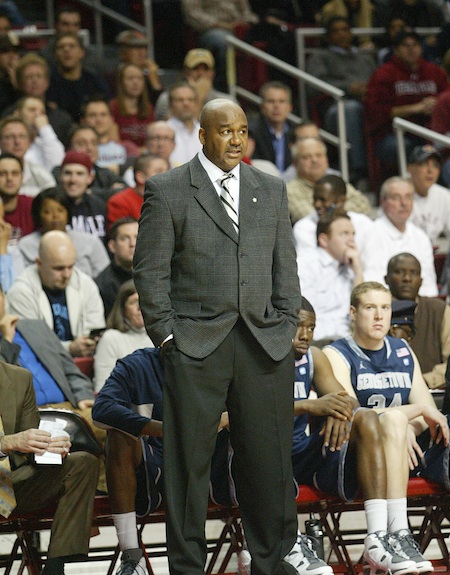The Georgetown Hoyas responded to a pair of glowing articles about their extraordinary shooting prowess with a brutal display from behind the arc [4/22] tonight in South Bend, falling to the Fighting Irish 69-55.
Let's run the numbers:
TEMPO-FREE BOX SCORE . Visitor Home . Georgetown Notre Dame . 1st Half 2nd Half Total 1st Half 2nd Half Total Pace 33 31 64 Effic. 78.3 93.8 85.8 102.4 113.2 107.6 eFG% 41.1 51.9 46.3 42.6 48.0 45.2 TO% 21.1 25.9 23.4 21.1 12.9 17.2 OR% 28.6 30.8 29.4 38.9 25.0 32.4 FTA/FGA 25.0 7.7 16.7 51.9 52.0 51.9 Assist Rate 80.0 61.5 69.6 60.0 80.0 70.0 Block Rate 21.1 11.8 16.7 13.3 5.9 9.4 Steal Rate 9.0 9.7 9.4 3.0 16.2 9.4 2FG% 46.7 70.6 59.4 36.8 35.3 36.1 3FG% 23.1 11.1 18.2 37.5 50.0 43.8 FT% 42.9 100.0 55.6 78.6 84.6 81.5
The stats for the game are a bit surprising, in that they belie the impression I took away from the game that Georgetown was beat in about every facet.
- The Hoyas were just a bit worse shooting from the field in the Lift-off half than the Irish, and were better shooters in the Vesper half. Overall, the Hoyas actually out-shot Notre Dame. How? In spite of going 4/22 [18%] from 3FG for the game, the Hoyas were much better on 2FGs tonight, 19/32 [59%] to 13/36 [36%].
- Georgetown was more effective inside because they took better shots inside - 15/22 [68%] on dunks, layups and tips versus 4/10 on 2-pt jumpers. Notre Dame was forced into taking half of their 2FGs as jumpers [4/18, 22%], and only converted half of their layups [9/18].
- Rebounding was a big concern tonight coming into the game, as the Irish were the third best defensive rebounding team in the nation at tip-off. Notre Dame did win the battle, but not in any sort of rout [29% vs. 32%]. ND simply grabbed one more offensive rebound than the Hoyas on the same number of opportunities - almost a statistical draw. The big difference was that the Irish were able to generate more points off of those offensive rebounds [16 to 9], with nine points on second chances in the first half.
- Turnovers were another interesting story coming into the game, a sort of irresistible force (NDU, at 15.3%, was 2nd from last in TO% forced coming into the game) versus the immovable object (Georgetown gives the ball up on 20.7% of its possessions). Tonight the object won in a landslide, as the Hoyas managed 15 turnovers on 65 possessions (23%), although only 6 were via Notre Dame steals. Strangely, the Irish were also generous, as they committed 11 turnovers themselves, above expectation - Notre Dame's TO% on offense was also 15.3% coming in.
So where did the wheels fall off?
Obviously the outside shooting was a big problem, but this wasn't Georgetown's first bad night shooting from outside this season - they went 2/9 vs. Utah State. But against the Aggies, the Hoyas compensated by pounding the ball inside [35:9 2FGA:3FGA] and got to the line, outscoring Utah St. 20-4 at the stripe.
Not tonight, as Georgetown sent the Irish to the bonus at 9:57 of the first half, and ended up trailing 11-3 in FTM at the break. It didn't get better in the second half (11-2), but quite a bit of that difference came on futile fouling by the Hoyas late in the game.
But it wasn't nearly as bad as you think.


